
- Wood From Original
- Age
- Brand
- Alfa Romeo (13)
- Andy Clancy Designs (9)
- Antique (21)
- Bbh Homes (15)
- Handmade (43)
- Japanese Netsuke (19)
- Jay Bigler, Maker (8)
- King (5)
- Lexus (10)
- Mercedes-benz (104)
- Nepal Forged (6)
- Original (20)
- Table (12)
- Threea (7)
- Toyokuni (7)
- Unknown (11)
- Volkswagen (5)
- Windlass Steelcraft (7)
- Wolf Creek (5)
- Wooden (22)
- ... (3555)
- Material
- Orientation
- Shape
- Style
- Abstract (30)
- Americana (78)
- Antique (46)
- Art Deco (37)
- Asian (20)
- Black Forest (26)
- Country (22)
- Expressionism (14)
- Folk Art (60)
- French (31)
- Impressionism (24)
- Mid-century Modern (54)
- Modern (19)
- Naive, Primitive (59)
- Realism (44)
- Rustic / Primitive (14)
- Traditional (19)
- Victorian (35)
- Vintage (20)
- Wood Block Prints (40)
- ... (3212)
Original 1893 Mahogany Wood Trim Section From Chicago Athletic Association
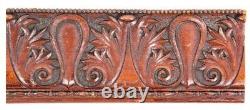
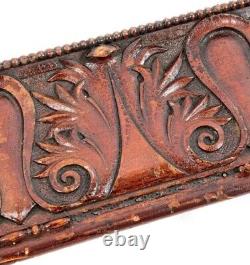
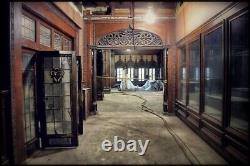
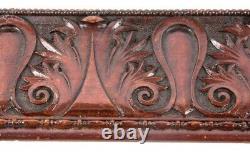
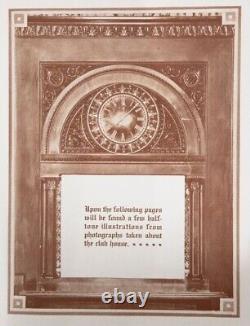
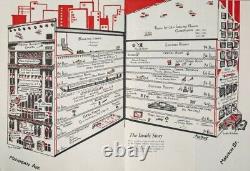
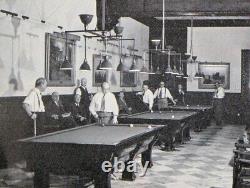
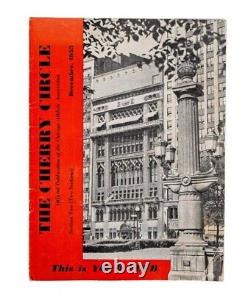
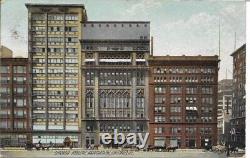
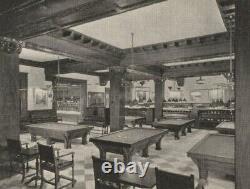


Henry Ives Cobb-Designed Original 1893 Hand-Carved Mahogany Wood Trim Section From Chicago Athletic Association Building. Original and intact late 19th century displayable american solid mahogany wood richardsonian romanesque style trimwork or molding fragment removed from the historically important chicago athletic association building billiard room. A very limited number of fragments and/or sections were removed during building alterations and/or renovations occurring as early as the 1930's.
The majority of the molding used throughout this grand room has remained amazingly intact. The fragments were removed and later stored away in the building's basement. The carefully cleaned and resized displayable fragment features a repeating pattern consisting of richly ornate hand-carved leafage with a lower bead-and-reel border. The original darkly stained finish remains in great condition, considering age.
The diminutive carved wood fragment has been carefully cleaned and denailed. The chicago athletic association was founded in 1890 by several elite chicagoans e. Marshall field, cyrus mccormick and a.Spalding as a non-profit organization that provided a setting for athletic, business and social activities. In 1891, the chicago athletic association announced it would build a "new gymnasium" on michigan avenue. In 1893 the building designed by architect henry ives cobb was completed.
The facade is considered one of the finest examples of venetian gothic revival in the united states. The architect, who was also a member, designed several other notable buildings, including, but not limited to, the chicago historical society, newberry library and several pre-1900 buildings at the university of chicago campus.
The building's principal facade, which of patterned brick and intricately carved indiana limestone, was based on the doges palace in venice. The distinctive exterior along michigan avenue gave the chicago athletic association a distinctive identity when viewed from the lakefront, particularly by visitors to the world's columbian exposition of 1893. The entrance and main lobby, designed by healy & millet, are heavily adorned with visually striking marble, mosaic and stained glass ornament. A reception room and writing lobby were hidden behind luxurious portieres. A broad stairway with a graceful curve, leads along a side-wall consisting of monolithic slabs of marble, transcending a ceiling of pure white stucco, divided into panel formations.The second floor presents, first, a lounging or reading room, finished in gothic style quartered oak extravagantly carved, which made for a graceful transition from the marble lobby to the mahogany-trimmed billiard room. The lounging room contains massive wood burning fireplaces with exceptional bas-relief carved oak wood panels depicting scrimmage in football. The oak columns with fretwork support heavy ceiling rows (and cross-rows) once profusely strewn with incandescent light bulbs. The adjoining billiard room contained nineteen tables and a cafe annex where members were served lunch. The third floor contained a library containing soft furnishings, luxurious divans and chairs, paintings, rugs and draperies.
It was here that, on "ladies' days", the women could find rest and solace. The immense dining room is located on the eighth floor. The main room covers approximately 6400 square feet. The room is finished in quartered oak and contains three bas-relief carvings, decorating the massive mantels. The overhanging stucco ceiling (mostly destroyed) contained an unusual "drooping tip" profile with gothic motifs.Two of the floors were devoted to lodging departments, comprising about sixty rooms. The ninth floor contained racquet, tennis, and squash courts, which, with the lounging and ante-rooms and lockers, occupied the entire floor. There were two racquet courts, one tennis court, one squash court, and one handball court, all of regulation size. The main floor of the club contains the "natatorium, " which was considered the pride of the club. The swimming or "plunge" room is finished in white marble, with an elegant neoclassical style stairway and balcony surrounding the pool.
The swimming pool or "tank" is forty feet wide by sixty feet long, and the depth graduates from eight to four feet. The room was equipped with spring boards, high dives, traveling rings, etc.
The adjacent turkish bath was equipped with steam, shampoo and rubbing rooms, and numerous showers.

